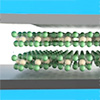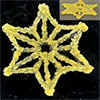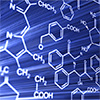May 02, 2024 (Nanowerk News) An international team, led by researchers from Australia, have developed a system using nanotechnology that could allow people with diabetes to take oral insulin in the future. The researchers say the new insulin could be eaten by taking a tablet or even embedded within a...
Researchers unlock potential of 2D magnetic devices for future computing
May 02, 2024 (Nanowerk News) Imagine a future where computers can learn and make decisions in ways that mimic human thinking, but at a speed and efficiency that are orders of magnitude greater than the current capability of computers. A research team at the University of Wyoming created an innovative...
Perovskite-based tandem solar cells
May 02, 2024 (Nanowerk News) Roof tiles are becoming a thing of the past: Today, more and more Swiss roofs boast large black and blue rectangles that convert sunlight into electricity. The blueish color comes from silicon crystals, as the majority of solar cells available today are based on this...
Random robots are more reliable
May 02, 2024 (Nanowerk News) Northwestern University engineers have developed a new artificial intelligence (AI) algorithm designed specifically for smart robotics. By helping robots rapidly and reliably learn complex skills, the new method could significantly improve the practicality — and safety — of robots for a range of applications, including...
Bioinspired magnetic soft actuators rapidly deform using bone-in-flesh constructs
May 02, 2024 (Nanowerk Spotlight) The field of soft robotics seeks to create compliant, adaptive actuators that mimic the remarkable abilities of biological systems. Conventional robotic actuators, built from rigid components and powered by electric motors or hydraulics, excel at speed and precision but struggle to match the versatility and...
Marriage of synthetic biology and 3D printing produces programmable living materials
May 02, 2024 (Nanowerk News) Scientists are harnessing cells to make new types of materials that can grow, repair themselves and even respond to their environment. These solid “engineered living materials” are made by embedding cells in an inanimate matrix that’s formed in a desired shape. Now, researchers report in...
Toxic chemicals can be detected with new AI method
May 02, 2024 (Nanowerk News) Swedish researchers at Chalmers University of Technology and the University of Gothenburg have developed an AI method that improves the identification of toxic chemicals – based solely on knowledge of the molecular structure. The method can contribute to better control and understanding of the ever-growing...







